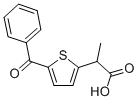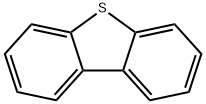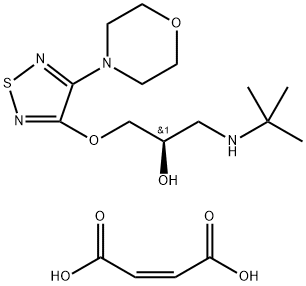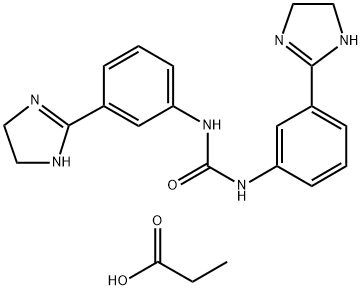Tiaprofenic acid
Synonym(s):(±)-Tiaprofenic acid
- CAS NO.:33005-95-7
- Empirical Formula: C14H12O3S
- Molecular Weight: 260.31
- MDL number: MFCD00866089
- EINECS: 251-329-3
- SAFETY DATA SHEET (SDS)
- Update Date: 2024-11-22 13:59:06

What is Tiaprofenic acid?
Absorption
Bioavailability is 90% following oral administration.
Chemical properties
White or almost white, crystalline powder.
Originator
Surgam,Roussel,France,1975
The Uses of Tiaprofenic acid
Antiinflammatory;Cyclooxygenase inhibitor
Indications
Tiaprofenic acid is used to treat pain, especially arthritic pain.
Background
Tiaprofenic acid is a non-steroidal anti-inflammatory drug employed in the treatment of pain, particularly arthritis pain. It belongs to the arylpropionic acid (profen) group of nonsteroidal anti-inflammatory drugs (NSAIDs).
What are the applications of Application
Tiaprofenic Acid is a non-steroidal anti-inflammatory compound on in vitro cells
Definition
ChEBI: An aromatic ketone that is thiophene substituted at C-2 by benzoyl and at C-4 by a 1-carboxyethyl group.
Manufacturing Process
A mixture of 10.3 g of thiophene-2α-methylacetic acid [prepared by process of Bercot-Vatteroni, et al., Bull. Soc. Chim. (1961) pp. 1820-21], 11.10 g of benzoyl chloride and a suspension of 23.73 g of aluminum chloride in 110 cc of chloroform was allowed to stand for 15 minutes and was then poured into a mixture of ice and hydrochloric acid. The chloroform phase was extracted with a 10% aqueous potassium carbonate solution and the aqueous alkaline phase was acidified with N hydrochloric acid and was then extracted with ether. The ether was evaporated off and the residue was crystallized from carbon tetrachloride to obtain a 54% yield of 5-benzoyl-thiophene-2α-methylacetic acid melting at 83°C to 85°C. The product occurred in the form of colorless crystals soluble in dilute alkaline solutions, alcohol and ether and insoluble in water.
Therapeutic Function
Antiinflammatory
Pharmacokinetics
Tiaprofenic acid is a non-steroidal anti-inflammatory drug of the arylpropionic acid (profen) class, used to treat pain, especially arthritic pain. The typical adult dose is 300mg twice daily. This drug is not recommended for use in the pediatric population.
Drug interactions
Potentially hazardous interactions with other drugs
ACE inhibitors and angiotensin-II antagonists:
antagonism of hypotensive effect; increased risk of
nephrotoxicity and hyperkalaemia.
Analgesics: avoid concomitant use of 2 or more
NSAIDs, including aspirin (increased side effects);
avoid with ketorolac (increased risk of side effects
and haemorrhage).
Antibacterials: possibly increased risk of convulsions
with quinolones.
Anticoagulants: effects of coumarins and
phenindione enhanced; possibly increased risk of
bleeding with heparins, dabigatran and edoxaban -
avoid long term use with edoxaban.
Antidepressants: increased risk of bleeding with
SSRIs and venlaflaxine.
Antidiabetic agents: effects of sulphonylureas
enhanced.
Antiepileptics: possibly increased phenytoin
concentration.
Antivirals: increased risk of haematological toxicity
with zidovudine; concentration increased by
ritonavir.
Ciclosporin: may potentiate nephrotoxicity.
Cytotoxics: reduced excretion of methotrexate;
increased risk of bleeding with erlotinib.
Diuretics: increased risk of nephrotoxicity;
antagonism of diuretic effect; hyperkalaemia with
potassium-sparing diuretics.
Lithium: excretion decreased.
Pentoxifylline: increased risk of bleeding.
Tacrolimus: increased risk of nephrotoxicity.
Metabolism
Hepatic (10%). Sparingly metabolised in the liver to two inactive metabolites.
Metabolism
Sparingly metabolised in the liver to two inactive metabolites. Excretion of tiaprofenic acid and its metabolites are mainly in the urine in the form of acyl glucuronides; some is excreted in the bile.
Properties of Tiaprofenic acid
| Melting point: | 96° (isopropyl ether) |
| Boiling point: | 373.57°C (rough estimate) |
| Density | 1.2959 (rough estimate) |
| refractive index | 1.5050 (estimate) |
| storage temp. | 2-8°C(protect from light) |
| solubility | Practically insoluble in water, freely soluble in acetone, in ethanol (96 per cent) and in methylene chloride. |
| form | neat |
| pka | 4.05±0.10(Predicted) |
| form | Solid |
| color | White to Almost white |
| λmax | 314nm(Phosphate buffer sol.)(lit.) |
| Merck | 14,9422 |
Safety information for Tiaprofenic acid
| Signal word | Danger |
| Pictogram(s) |
 Skull and Crossbones Acute Toxicity GHS06  Health Hazard GHS08 |
| GHS Hazard Statements |
H301:Acute toxicity,oral H361:Reproductive toxicity |
| Precautionary Statement Codes |
P201:Obtain special instructions before use. |
Computed Descriptors for Tiaprofenic acid
Abamectin manufacturer
Varanous Labs Pvt Ltd
New Products
4-Aminotetrahydropyran-4-carbonitrile Hydrochloride (R)-3-Aminobutanenitrile Hydrochloride 4-AMINO-TETRAHYDRO-PYRAN-4-CARBOXYLIC ACID HCL 4-(Dimethylamino)tetrahydro-2H-pyran-4-carbonitrile 3-((Dimethylamino)methyl)-5-methylhexan-2-one oxalate 1,4-Dioxa-8-azaspiro[4.5]decane 5-Bromo-2-nitropyridine Nimesulide BP Aceclofenac IP/BP/EP Mefenamic Acid IP/BP/EP/USP Diclofenac Sodium IP/BP/EP/USP Ornidazole IP Diclofenac Potassium SODIUM AAS SOLUTION ZINC AAS SOLUTION BUFFER SOLUTION PH 10.0(BORATE) GOOCH CRUCIBLE SINTERED AQUANIL 5 BERYLLIUM AAS SOLUTION 2-Bromo-1-(bromomethyl)-3-chloro-5-nitrobenzene 2-Bromo-3-nitroaniline N-(3-Hydroxypropyl)-N-methylacetamide 3-Bromo-6-chloropyridazine 4-ethyl-3-nitrobenzoic acidRelated products of tetrahydrofuran








You may like
-
 33005-95-7 Tiaprofenic acid 98%View Details
33005-95-7 Tiaprofenic acid 98%View Details
33005-95-7 -
 Tiaprofenic Acid CAS 33005-95-7View Details
Tiaprofenic Acid CAS 33005-95-7View Details
33005-95-7 -
 Tiaprofenic acid 95% CAS 33005-95-7View Details
Tiaprofenic acid 95% CAS 33005-95-7View Details
33005-95-7 -
 Tiaprofenic acid CAS 33005-95-7View Details
Tiaprofenic acid CAS 33005-95-7View Details
33005-95-7 -
 1823368-42-8 98%View Details
1823368-42-8 98%View Details
1823368-42-8 -
 2-(3-(tert-butyl)phenoxy)-2-methylpropanoic acid 1307449-08-6 98%View Details
2-(3-(tert-butyl)phenoxy)-2-methylpropanoic acid 1307449-08-6 98%View Details
1307449-08-6 -
 Ethyl 3-(furan-2-yl)-3-hydroxypropanoate 25408-95-1 98%View Details
Ethyl 3-(furan-2-yl)-3-hydroxypropanoate 25408-95-1 98%View Details
25408-95-1 -
 Lithium ClavulanateView Details
Lithium ClavulanateView Details
61177-44-4